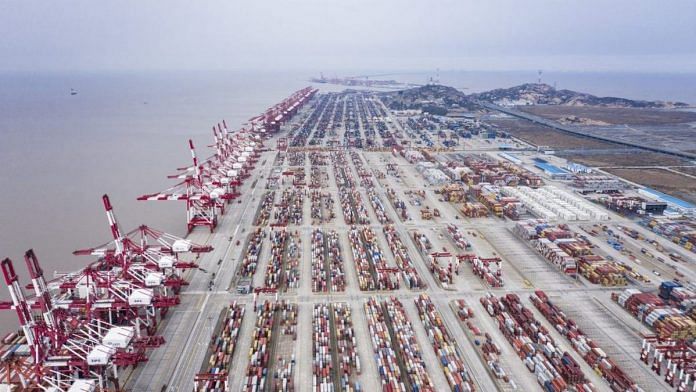New Delhi: Chinese products are flooding the Indian market, evading existing duties and other restrictions placed by the Indian government, a group of ministers (GoM) set up to promote Indian manufacturing has found in its report.
From soybean to telephone equipment to vehicles and their parts, the report found that many Chinese products are being rerouted from other countries to benefit from India’s trade agreements with other nations. It also found that the Indian market is being flooded with counterfeit goods — or cheaper-quality versions of well-known brands — in segments like footwear, clothing, leather, watches and electrical equipment like chargers.
Data from the Ministry of Commerce shows that the majority of these items are imported from China.
The GoM is headed by Textiles and Women and Child Development Minister Smriti Irani, and submitted its report to the government in October. ThePrint has accessed a copy of the report.
The report has been shared with all ministries concerned for taking action on the recommendations. But the government moved to plug some of these loopholes even prior to the submission of the report.
For instance, the Department of Revenue has moved to plug the loopholes under the ‘rules of origin’ provision to ensure that only items genuinely manufactured in countries with whom India has a free trade agreement get the benefit of lower import duties. It has put in conditions like minimum value addition for preferential customs duty to be applicable.
It had also tightened norms around soybean oil imports to prevent misuse of the SAFTA agreement.
Also read: Traders’ body calls for boycott of 3,000 Chinese products over ‘continued’ border clashes
Monitoring HS codes
The GoM has advocated strict action to prevent such abuse of the rules. It proposes setting up an India Strategic Trade Agency (ISTA) for monitoring ‘HS code’ changes to identify misuse and ensure identification, and take stringent action against counterfeiting.
‘HS codes’ are used for classification of goods, and are followed across countries for a standardised classification and imposition of tariffs.
The report suggested “stringent checking for identified HS codes — 64 (footwear), 61 (apparel), 42 (leather products), 91 (clocks and watches), 85 (electrical machinery and equipment) — to limit the import of counterfeit products”, and said this could potentially save $15 billion.
In all these HS codes, China had the largest share in India’s import basket.
Different modus operandi
The GoM report also flagged that between 20-30 per cent of products imported into India come under the ‘other’ category, accounting for around $130 billion, and this is primarily done to avoid duties and taxes.
India also suffers due to abuse of ‘rules of origin’ by other countries, it stated.
Citing the example of vehicles and parts, the GoM pointed out that there was a sharp surge in their import from Singapore and Hong Kong, after India imposed an anti-dumping duty on their import from China.
The report also said how import of these items from China slowed down in the subsequent years, but that from Singapore and Hong Kong rose by 13,000 per cent and 277 per cent respectively.
“There is, therefore, believed to be a strong correlation with China’s reduced exports, rerouted to evade import duties and exploit trade agreements of India with Hong Kong and Singapore,” it added.
The soybean example
The GoM also cited the example of the massive surge in soybean oil imports from Nepal and Bangladesh after the formulation of the South Asia Free Trade Area agreement or SAFTA.
There was a 23,500 per cent increase in soybean oil imports since 2016-17, despite the fact both countries have limited production of soybean, and limited capacity to crush it, the report showed.
“Soybean from China was in this case being routed through Nepal or Bangladesh by flouting WTO rules of origin for getting duty exemption provided under SAFTA,” it said, stressing the need to review existing preferential trade agreements that have placed Indian manufacturers on the back foot.
According to government estimates, India only has a 2.8 per cent share in global manufacturing. Over the last one year, the government has taken many steps to promote Indian manufacturing, including a sharp cut in corporate tax rates and a push for Atmanirbhar Bharat (self-reliant India). The government also imposed customs duties on some products to promote local manufacturing.
Also read: Why India needs to give some troubled Chinese companies a nest here




Why Cry? Why can’t we do the same? We have FTA with Vietnam, route stuff to China or all the RCEP members through Vietnam, Malaysia and any country we have FTA with.